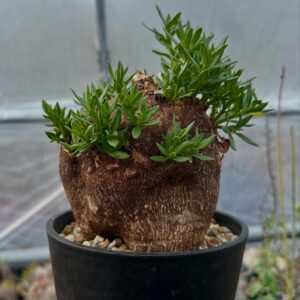, commonly known as the Venda cycad, is a critically endangered species of cycad native to the Limpopo Province in South Africa. It was first described by P.J.H. Hurter in 1996. Here are some key characteristics and facts about this species:
-
: The plant has an erect, unbranched stem that can grow up to 3-4 meters tall and 35-40 cm in diameter. It often becomes decumbent with age and may sucker at the base.
-
: The leaves are pinnate, arranged in a crown at the apex of the stem, and can reach lengths of 1.1-1.4 meters. They are bluish-green on the upper side and paler green on the lower side, with elliptic leaflets that have thorny apices.
-
: Male plants produce 2-5 cylindrical-ovoid cones, while female plants produce 1-3 ovoid cones. The cones of female plants are typically glaucous green and glabrous.
-
: Found in the Soutpansberg region of Limpopo Province, South Africa, on southeast-facing quartzite cliffs and in open grassland and shrubland.
-
: Grows at elevations between 800 and 1,000 meters above sea level.
-
: Listed as Critically Endangered by the IUCN, possibly extinct in the wild due to illegal harvesting for private collections.
-
: The population declined significantly from an estimated 400-500 plants when first described to fewer than 10 individuals by 2020.
-
: Prefers full sun but tolerates light shade and is frost tolerant. It grows slowly and requires well-drained soil to thrive.
-
: Propagated from seeds and suckers, with artificial pollination necessary for successful seed production in cultivation
how to cultivate Encephalartos hirsutus
To successfully cultivate Encephalartos hirsutus, follow these guidelines:
1.
-
Choose a site with filtered sunlight or partial shade, especially during the seedling stage, to prevent scorching.
-
Mature plants can tolerate full sun but should be acclimatized gradually if moved outdoors.
2.
-
Use well-draining soil to prevent root rot. A mix of sand, perlite, and organic matter is ideal.
-
The soil should have a slightly acidic to neutral pH.
3.
-
Maintain consistent moisture without waterlogging the soil. Overwatering is a common cause of cycad failure.
-
Allow the topsoil to dry slightly between waterings.
4.
-
Encephalartos hirsutus thrives in warm climates with temperatures between 20°C and 30°C.
-
Protect from frost and cold conditions below -5°C by moving plants indoors or providing insulation.
5.
-
Feed with a slow-release fertilizer rich in potassium and nitrogen during the growing season (spring to summer).
-
Avoid over-fertilizing, as cycads are slow-growing and sensitive to nutrient buildup.
6.
-
Propagate using seeds or basal suckers:
-
Seeds: Soak in water to break dormancy, then plant in well-draining soil at warm temperatures (20–30°C).
-
Suckers: Remove carefully from the base of the plant and replant in suitable soil.
-
7.
-
Monitor for scale insects and mealybugs, which can damage leaves. Use insecticidal soap or neem oil as needed.
8.
-
Move plants outdoors during frost-free months for better air circulation and sunlight.
-
Clean leaves regularly if grown indoors to ensure proper photosynthesis.
By providing these conditions, Encephalartos hirsutus can thrive, though patience is essential due to its slow growth rate.
What are the ideal growing conditions for Encephalartos hirsutus
-
: Best suited for warm temperate and subtropical climates. It is frost-tolerant to a degree but should be kept dry during winter if temperatures drop below 10°C. Heavy frosts can be fatal.
-
: Requires well-drained, slightly acidic to neutral soil enriched with compost. The soil must allow for proper aeration to prevent root rot.
-
: Moderate watering is needed, especially during dry periods. Overwatering should be avoided as the plant does not tolerate excessive moisture.
-
: Naturally found at elevations of 800–1,000 meters on quartzite cliffs in semi-deciduous shrubland with annual rainfall of 350–650 mm, primarily in summer.
-
: Benefits from a balanced fertilizer (NPK) with micronutrients during the growing season to enhance growth
What are the best locations for growing Encephalartos hirsutus in a home garden
The best locations for growing Encephalartos hirsutus in a home garden should mimic its natural habitat and provide the following conditions:
-
: Warm temperate or subtropical regions are ideal. The plant can tolerate light frosts but should be protected from heavy frosts or extremely cold temperatures (below 10°C).
-
: Full sun exposure is preferred for optimal growth and foliage color, though partial shade is acceptable, especially for seedlings.
-
: Use deep, fertile, well-drained soil enriched with compost. Slightly acidic to neutral soil is best for healthy root development.
-
: Moderate watering is required, especially during dry periods. However, ensure the soil does not become waterlogged, as this can lead to root rot.
-
: Plant in a location with excellent drainage, such as a raised bed or slope, to prevent water stagnation.
-
: Provide ample room for the plant’s slow-growing but eventually large size. Its taproot also needs sufficient space to develop.
-
: In areas with cold winters, consider planting in a container that can be moved indoors or provide winter protection by keeping the plant dry and insulated.




Reviews
There are no reviews yet.